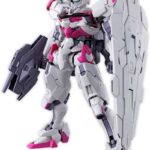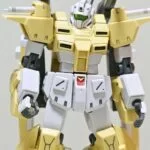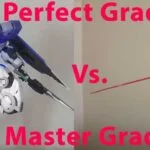High Grade Vs Master Grade | Should You Take A Step Forward
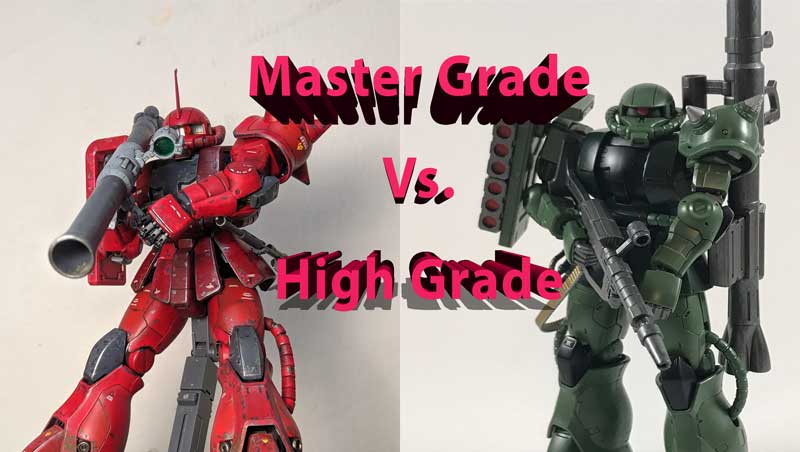

there are many differences between High grade and Master grade Gundam models, and size is just one of them. These two grades are actually different from each other in any single aspect, there is nothing they share in common.
Here is a sum of the differences between these two lines of Gundam kits in the table below:
| Feature | High Grade | Master Grade |
| Frame | No Inner Frame | Inner Skeleton Frame |
| Ease of Building | Easy To Build | Moderate Difficulty |
| Color Separation | Average | Exceptional |
| Gimmicks | Basic | Advanced |
| Scale | 1/144 or 1/100 | 1/100 |
| Size | 13 com or 18cm | 18cm |
| Shelf Space Consumption | Economical | Takes more space |
| Variety | Wide Variety | Limited Variety |
| Price Range | $20-$40 | $30-$60 |
The Main Differences Between High Grade And Master Grade
The first and major distinction between a High Grade and a Master Grade Gundam kit is that MG kits have inner skeleton frames, whereas HG kits do not.
Then there’s their size. Even a complete novice will notice that MG kits are larger than HGs at first glance.
Another distinction is the separation and variation of their colors. Master Grades are also the better option in this case. Most kits in both grades have nice color combinations, but MG kits have much better color separation.
There are many other differences between these two grades but don’t worry, we’ll go over them all in detail; keep reading for a complete comparison of the grades.
Frame – MG has a frame while HG don’t
High Grades and Master Grades could not be more different in this regard. Unlike MG kits, HG kits do not have frames; instead, each part of the body connects to other parts rather than to a frame.
This reduces stability and stamina because these kits are essentially hollow plastic bodies with only polycap joints inside.
MG kits, on the other hand, have sturdy inner frames that give them extra stamina and good articulation, giving them an advantage over their lower grade counterparts. Some Master Grade kits include special stands to improve stability and posture.
High Grade Kits Are Easier To Build Then Master Grade Kits
If you’re concerned about the ease of building, a High Grade kit is the way to go.
- It is one of the most important features of HG kits. A High Grade kit can be completed in 5 to 6 hours.
HG kits are suitable for both beginners and experts, as well as builders of all ages. If you’re a beginner Gunpla builder looking for something not too difficult, I recommend starting with a High Grade kit.
HG kits are ideal for perfecting your painting and building skills due to their simple construction.
Master Grades, on the other hand, have a more complicated setup that necessitates more effort to construct. As previously stated, MG kits include inner skeleton frames on which you will arrange the parts one by one. While this improves articulation, it is also quite complex and can be discouraging for a beginner.
- Depending on your level of expertise and taste, the average build time for MG kits can range from one day to a few days.
Master Grade is ideal for the average Gunpla builder who wants a little more difficulty with more details and at a medium size.
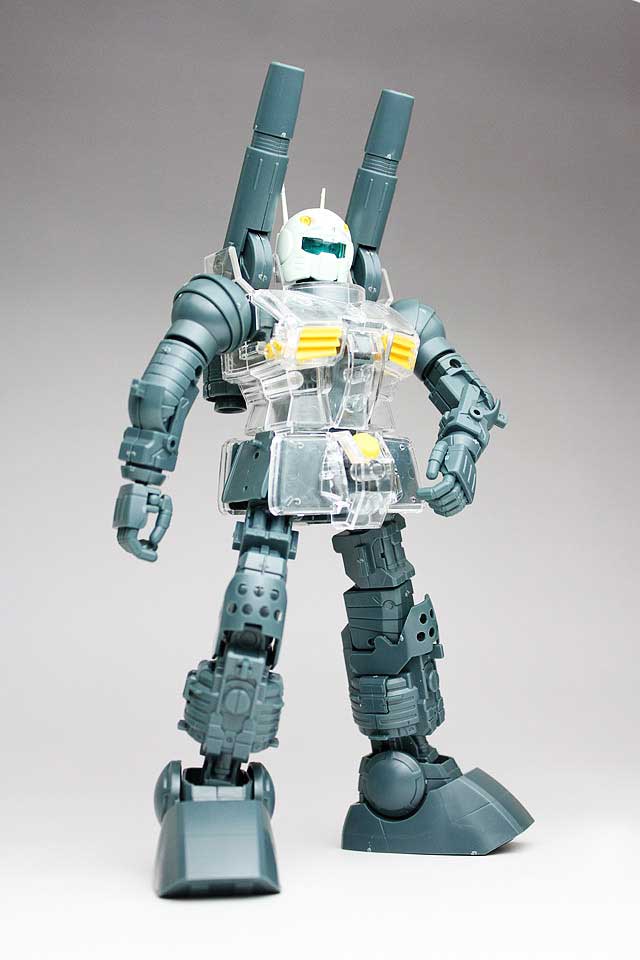

What About Details?
The detailing on Master Grade kits is far superior to that on High Grade kits.
- HG has the fewest details out of the four most popular grades (HG, MG, RG, and PG).
This is not to say that it is completely bad; it is simply not as detailed as the others.
Also, some High Grades are more detailed than others, such as the HG Moon Gundam, and may even be more detailed than older versions of better grades. When comparing grades of the same timeline, HG kits are the least detailed.
HG kits are typically detailed to a moderate level. They look good right out of the box without any painting, and the details can be improved with panel lining and a few small paintings in a few key areas. Most HG kits include Polycaps and decal stickers.
- Master Grade kits are highly detailed. They are the most detailed Gundams in the low-budget range.
The majority of MG kits require little to no painting, but their details will benefit greatly from panel lining and decals.
Another cool feature that I think distinguishes MG is that some of their kits are LED-compatible. They can be outfitted with LED lights to enhance the kit’s details and make it more visually appealing.
HG Vs. MG – Color Separation
- The majority of Gundam kits are not painted by default. Instead, parts are made in various colors to give the model a nice anime aesthetic.
This is referred to as color separation.
Both HG and MG kits have excellent color separation and can be used right out of the box, but Master Grades kits have much better color separation.
Although the majority of High Grade kits have good color separation, they still rely on stickers to improve their appearance and detailing.
Although it is better on newer HG models with fantastic color separation, such as the Gundam HGUC and Gundam HGTWFM lines.
Color separation is one of the best characteristics of an MG kit.
Master Grades are well-designed with attention to detail and color separation; they rarely use color-correcting stickers, but when they do, it’s usually in tiny places that are easily overlooked.
Gimmicks – Master Grade Gunpla Has Twice More Then High Grade
HG has fewer gimmicks than Master Grades.
An average Master Grade kit will have roughly twice the amount of gimmick than a High Grade kit on a good day.
Detachable swords, open and close hatches, working hydraulics, and model transformation are all common features of MG kits.
This, however, has a disadvantage. Gimmicks and sophistication imply more tiny body parts that are easily misplaced and usually difficult to assemble.
High Grades, on the other hand, does fairly well with gimmicks, but not exceptionally so, as with many of their other features. HG kits, in general, are simple, with just the right amount of gimmicks.
However, modern HG kits are more developed, with a surprising number of mechanical parts and improved articulation.
Some have inner frames as well. The HGIBO subline is one example.
Scale – Master Grade Is A 1/100 Scale and High Grade Is 1/144
The size of a kit when assembled is determined by the scale in which it is built. The smaller the size, the larger the scale, and vice versa.
High Grades are constructed in a 1/144 scale, while Master Grades are constructed in a 1/100 scale.
As a result, Master Grade kits are bigger than High Grade kits. Although some legacy HG kits are built in a 1/100 scale, such as the RE100 line, which is a High Grade in terms of articulation and details but is built in a 1/100 scale.
HG kits are typically 13cm in size, or about 5 and a half inches, whereas Master Grade kits are typically 18 to 20cm in size, or about 7 to 8 inches. Keep in mind that these are average values; larger and smaller kits are available.
- High Grades are ideal if you prefer small portable kits or want to display multiple kits on small shelf space. However, MG is the kit to choose from if you need something larger and with more shelf presence.
The Difference In The Variety Of Each Grade
High Grades are the most collectible line of Gundam kits because they are inexpensive, great for all levels of experience, and, most importantly, have the most kits of any grade.
There are over 300 different types of HG kits to choose from, not counting some special kits. When compared to Master Grade’s approximately 200 kits, this is an impressive lineup.
Another advantage of HG is that the majority of them use the same or similar connection, making the parts of different kits interchangeable.
They are ideal for kitbashing.
MG’s lineup is more limited than HG’s.
Because of the time and resources required to construct the inner frames and many parts of MG kits, Bandai has become more selective in deciding which Gundam character will receive an MG kit.
The availability of a wide range of High Grades has also reduced its scarcity. You’re more likely to find an HG kit than an MG or any other grade.
Master Grades are scarce, especially in older versions of kits. However, Bandai caters to this by making recent kits more widely available and reproducing older ones. The RX-78-2 Gundam, for example, has at least seven different MG versions.
On that note, HG is the best option if you want a line with rare suits or if you want to collect an entire team from a specific series.
HG Will Take Less Shelf Space
Most High Grade kits are significantly smaller than Master Grade kits.
HG kits are 1/144 scale and much smaller in size than MG kits, which are 1/100 scale.
A typical MG kit will take up at least twice the space of a typical High Grade kit. While MG kits don’t have the same shelf presence as PG kits, they’re still noticeable and perform better than High Grades.
With HGs, you can also amass a large army of warriors and easily fit them all on your limited shelf space.
Price differences
As previously stated, High Grades are the most collectible lines of Gundam kits, owing in part to their affordability. They are significantly cheaper than Master Grades.
An average High Grade kit costs between $20 and $40, while a Master Grade kit costs between $30 and $60. Some MG kits can cost as much as $100, depending on the features and rarity. Some special kits, such as the Deep Striker, can cost up to $180.
To be fair, Master Grades are still quite affordable, especially when compared to higher grades such as Perfect Grade, which costs around $300.
Conclusion
High Grade (HG) and Master Grade (MG) are two popular grades of Gundam model kits.
HG kits are smaller, easier to build, and have less complex inner frames compared to MG kits. They are more economical in terms of shelf space consumption, have a wider variety, and are suitable for beginners.
On the other hand, MG kits have inner skeleton frames, are larger and more detailed, require more skill to assemble, and take up more shelf space. They are considered to be for the more experienced model builder, who is willing to put in the extra time and effort for a more detailed model.

